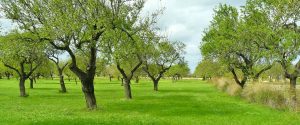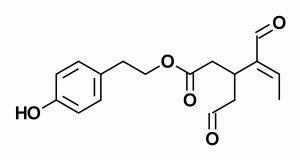Olive (Olea europaea)
Olive, the remedy for those suffering from mental or physical exhaustion, is made by the sun method.

Olive trees; image from pixabay.com
Many artists have painted olive trees. Renoir spent the last 11 years of his life living in a house in south-east France which he bought to prevent the olive groves being destroyed to make a market garden. He struggled to paint the trees saying they were full of colours, always changing – the colour lay between the trees not in the leaves. He said “The olive tree, what a brute! If you realised how much trouble it caused me”. Van Gogh also painted at least 18 pictures of olive trees. Recently, crop artist Stan Herd reproduced one of them, in a project funded by the Minneapolis Institute of Art (MIA). The work, based on the 1889 painting ‘Olive Trees’, covered 1.5 acres near Minneapolis Saint Paul International Airport.
Over 90% of olives are used for oil – the fruit is macerated, the stone removed then the pulp is cold pressed to extract virgin olive oil. This has the best flavour and the highest cost. Subsequent pressings yield lower quality oils, including refined olive oil which has been treated with charcoal and filtered and olive pomace, which is often used for cooking.

Olive oil; image from pixabay
Virgin oil is often adulterated with cheaper oils such as canola or sunflower. Over 50% of extra virgin oil in Italy and about 80% of that sold in the USA is believed to be adulterated. The profit margin on selling adulterated oil is three times that on selling cocaine and the process is under the control of organised crime – nicknamed the Agromafia.
Extra virgin oil contains oleocanthal, a phenolic compound responsible for the burning sensation when eating the oil. It has antioxidant and anti-inflammatory properties – in fact, it inhibits the COX enzymes so reducing pain and inflammation in the same manner as popular drugs such as ibuprofen and aspirin do. 50 g of oil contains enough oleocanthal to give similar anti-inflammatory effects as 1/10 of the adult dose of ibuprofen. It has been suggested that long-term consumption of small quantities may be responsible in part for the low incidence of heart disease and Alzheimer’s disease associated with a Mediterranean diet.

Chemical diagram of oleocanthal
Oleocanthal also has potential benefits in the treatment of cancer – acting very quickly and targeting cancer cells rather than healthy ones. It pierces the cancer cells’ waste storage containers, or vesicles, releasing enzymes that cause cell death. Cancer cells are affected in under an hour while healthy cells only suffer a temporary halt to their life cycles and this returns to normal after 24 hours.
Olives also contain the omega-9 fatty acid oleic acid, present as a triglyceride which, although named after olives, is common in the human diet. It is released by some types of bees, woodlice and ants to signal that they’re dead – they are then removed by their mates. When a living ant was daubed with oleic acid in an experiment, it was dragged off for disposal as if it were dead. The oleic acid smell also may indicate danger to living insects, prompting them to avoid others who have succumbed to disease or places where predators lurk.

Olives; image from pixabay
In many cultures, olive trees and olive oil were considered sacred. The olive branch was often a symbol of abundance, glory and peace. Moses exempted from military service those who worked on their cultivation, so important were they considered. Leafy olive branches were found in Tutankhamen’s tomb. Olive oil was used to anoint kings and athletes in ancient Greece. It was burnt in the sacred lamps of temples as well as burning as the “eternal flame” of the original Olympic Games. Victors in these games were crowned with its leaves.
Olive leaf teas were used to lower fevers and, used in poultices, are among the oldest treatments for infections of the skin, cuts and bruises. The oil is today used in cooking and skincare as a massage oil or in haircare and is a home remedy for hair lice.
For an introduction or sources and more info., click the links.